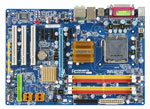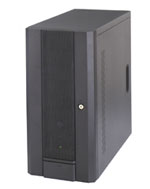Intel Budget Gaming
Traditionally, Intel offerings have tended to be on the more expensive side than configurations from AMD. However, as you shall see, this time the shoe is on the other foot, and we have a very competitive offering from Intel. It's no longer necessary to compromise performance in concession to the almighty dollar, and we are looking at two very strong budget gaming rigs from AMD and Intel.
| Intel Budget Gaming PC |
| Hardware |
Component |
Price |
Rebates |
| Processor |
Intel Core 2 Duo E4500
(2.2GHz 65W Allendale 2MB L2) |
$127 |
- |
| Motherboard |
Gigabyte GA-P35-DS3L
Intel P35 ATX |
$90 |
- |
| Memory |
Crucial Ballistix 2GB (2x1GB) DDR2-800 PC2-6400 |
$90 |
$40 |
| Video Card |
PNY GeForce 8800GT 512MB PCI-e 2.0 HDCP |
$260 |
- |
| Hard Drive |
Samsung SpinPoint T Series HD321KJ
320GB 16MB 7200RPM SATA 3.0GB/s |
$75 |
- |
| Optical Drive |
Samsung 20X DVDRW/DL SH-S202G |
$28 |
- |
| Case |
APEX TU150 Black Steel ATX with 400W |
$59 |
- |
| Display |
Acer 20" AL2016WBbd 5ms Widescreen DVI
(1680 x 1050) |
$200 |
- |
| Speakers |
Logitech X-530 70W RMS 5.1 |
$55 |
- |
| Input |
Logitech LX-710 Laser Black USB |
$55 |
- |
| Operating System |
Microsoft Vista Home Premium OEM |
$112 |
- |
| Bottom Line |
$1151 |
$1111 |
 |
Yes, we know we could have gone with the E6550, but that inches our budget up to nearly $1200 - close enough to our last midrange setup to make the difference rather meaningless. The E4500 clocks in at 2.2GHz and uses the Allendale core with just 2MB of L2 cache, while officially only supporting the older 800MHz Front Side Bus. The Allendale also lacks support for Intel's Virtualization technology, but some users are reporting the G0 stepping includes this. With our requirements, this is a moot point as it is mainly for use in server environments. The E4500 has proven to be a good overclocker and regularly overclocks in excess of 3.2GHz. Strangely, Newegg is listing the E4500 as $2 cheaper than the 2GHz E4400.
 |
With Intel G31/G33 motherboards providing woeful IGP performance compared to offerings from NVIDIA or AMD, how does Intel's enthusiast non-IGP chipset perform? Thankfully, it performs extremely well. Carrying on from the highly successful P965 series, we have the P35 chipset. Seemingly built with overclocking in mind, abit, ASUS, DFI, and Gigabyte have managed to produce a very nice selection of P35 motherboards for gamers. However, for our budget, we are limited to just a couple of options: the abit IP-35E or the Gigabyte GA-P35-DS3L. In the end, we chose the latter, because even though it is at the bottom of the P35-DS3 range from Gigabyte, it has proven to have all the vital features and overclocking ability of its more expensive brethren - and at a very attractive price.
 |
By this time, you may be wondering why we chose not to include an aftermarket CPU heatsink to go along with our CPU choices. For this budget, a $50 solution from Thermalright or Scythe was simply not an option, but with the stock AMD and Intel heatsinks incorporating heatpipe technology, we figured we'd still be good for a decent if not spectacular overclock.
The rest of the components are the same as those found in the AMD budget gaming system, and with AMD's HD 3800 (RV670) series still a couple of weeks away, the 8800 GT was an easy choice. Considering that overclocking will stress the CPU, motherboard, and RAM, it may be a wise investment to upgrade the power supply to something from Seasonic, Corsair, Enermax, or even Antec. Sound cards at this budget are simply an unnecessary luxury, and although a Creative Sound Blaster X-Fi would be an addition to complete our configuration, we're happy with onboard offerings - not to mention those soundcard driver issues we mentioned at the beginning; those were issues with the X-Fi.













63 Comments
View All Comments
JarredWalton - Thursday, November 8, 2007 - link
I don't know if the performance is as good in every area, but they are very quiet, cool running, and I have several that have not caused me any trouble. I have plenty of Seagate and WD drives as well. Outside of the Raptor drives (which are LOUD!) I couldn't tell which drive is which without looking at the case or running some sort of utility to look.Martimus - Thursday, November 8, 2007 - link
Why was the display price $10 cheaper on the Intel build than the AMD build?JarredWalton - Thursday, November 8, 2007 - link
Jonathan originally selected a D-Sub only LCD, and we switched to a DVI model. Missed the price updates, though. It ends up being $20 more for DVI, but it's definitely worth the money in my book. Prices should all be correct now (I hope).Martimus - Friday, November 9, 2007 - link
The display is still $10 cheaper on the Intel non-gamer build.JarredWalton - Friday, November 9, 2007 - link
Ah... I updated the gamer builds and missed the base builds. Fixed.Martimus - Friday, November 9, 2007 - link
Thanks. I was originally confused as to whether there was a rebate on the monitor if you bought an Intel chip with it or something. Maybe I should do something like this to update my old computer, because it doesn't really need to be top of the line or anything.crimson117 - Thursday, November 8, 2007 - link
Windows Vista Home Premium OEM costs $112 - that's over 18% of the computer's cost!You could cut the price of the computer down to $486 if you used Ubuntu instead of Windows Vista. If you were really cutting costs, you could also get away with 1GB of ram with Ubuntu, although ram is very cheap these days so it wouldn't save that much.
stmok - Saturday, November 10, 2007 - link
Yeah, agreed. Its crazy that if you drop Windows in the "Entry-Level PC" category, you can get a more powerful CPU or even a video card instead of an IGP.Zan Lynx - Thursday, November 8, 2007 - link
I used to use Linux for gaming, until I decided to use Windows again on my newest system. So I can say that while id games are good, and Transgaming Cedega does OK, it is a whole lot easier to use Windows. $112 is 3 or 4 games worth of money. Well worth it to avoid the hassles, in my opinion.I also have an opinion on 1 GB RAM. The Linux laptop I am writing this on only has 1 GB and I often curse it for the slowpoke it is. Combined with a laptop hard drive, 1 GB RAM is not enough. Serious multitasking with many web browser windows, an email client, a RSS client, a NNTP client, 10 or 20 terminal windows, BitTorrent, etc, etc, and before you know it, that 1 GB is almost gone and it certainly reduces your file cache, forcing programs to read disk all the time.
Get as much RAM as you can afford and will fit, I say.
BladeVenom - Thursday, November 8, 2007 - link
You can find the Vista Home Premium Upgrade edition cheaper than the OEM version. And it's better for anyone who builds, and upgrades their PC.